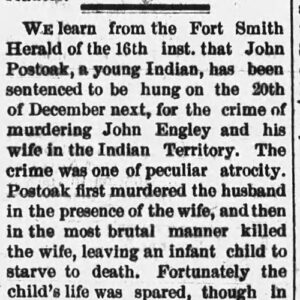calsfoundation@cals.org
John Postoak (Execution of)
On December 20, 1878, a Creek man named John Postoak was executed at Fort Smith (Sebastian County) after being convicted of the murder of a white man named John Ingley and his wife.
Little is known about John Postoak except that the Wilmington Daily Gazette reported that he was the son of a member of the Creek Council. Reports indicated that he was twenty-five years old. In early October 1877, Postoak went to Ingley’s remote home near Eufala (in what is now Oklahoma). A later report in the Fort Smith New Era holds that Postoak first requested that Ingley’s wife write two letters for him, “which he expected to send to Okmulgee by Ingley,” but that Ingley replied that he “was not going to Okmulgee and did not care to have him [Postoak] around anyway.” Postoak then requested some tobacco, and Ingley replied that he had no tobacco and regarded Postoak as “no better than a dog.” In response, Postoak traveled to a neighbor’s house, borrowed a revolver, and then returned to Ingley’s place and challenged him to take his own gun in hand. When Ingley attempted to do so, Postoak shot him and then killed his wife.
Historian Jerry Akins states that, twelve days after the murder, Postoak ran into some people on their way to the Ingley home. Knowing they might discover the bodies, he confessed but threatened them if they ever told. The next day, another group came upon the murder scene and discovered the bodies and Ingley’s young child, less than two years old. The child was still alive, but in critical condition; sources differ as to whether it survived, with one report saying that the infant had been cared for by local Native Americans and subsequently sent to family friends in Texas. The bodies of the two adults had been scavenged by wild animals.
Postoak was tried at the July 1878 term of the circuit court and found guilty on August 16. On October 14, he was sentenced to die. The Chicago Tribune reported on Postoak’s sentencing on October 19. Opining that “there seems to be something in the climate of the Southwestern States that makes men brutal and savage,” the Tribune described Postoak as “another fiend in human shape.” The reporter added that “Postoak received his sentence with the utmost indifference.”
On December 20, Postoak was hanged along with another convicted murderer, an African American man named James Diggs. Akins notes that this was the first hanging in Fort Smith in a little over two years, and that it was not a public spectacle. The fence around the site had been raised to sixteen feet, and no one was allowed inside the garrison except reporters, doctors, lawmen, clergymen, and others with passes. According to the Wilmington Daily Gazette, both men confessed to their spiritual advisers while still in the jail. They “mounted the scaffold with firm step,” and after a brief religious service Diggs gave a short speech. Postoak then prayed for ten minutes in his native language. During the execution, Postoak was reportedly stoic and “did not apparently move a muscle.” The Fort Smith New Era reported that Postoak had, prior to his execution, “adopted the Methodist faith as the channel through which to repent of his past misdeeds.”
For additional information:
Akins, Jerry. “Hangin’ Times in Fort Smith.” Journal of the Fort Smith Historical Society 27 (April 2003): 13–20. Online at https://uafslibrary.com/fshsj/27-01_Complete_Issue.pdf (accessed February 20, 2024).
“Arkansas.” Wheeling Register, August 24, 1878, p. 1.
“Execution of an Indian and a Colored Man in Arkansas.” Daily Gazette (Wilmington, Delaware), December 21, 1878, p. 4.
“The Gallows.” Fort Smith New Era, December 18, 1878, p. 3.
Untitled. Chicago Daily Tribune, October 19, 1878, p. 4.
“A Victim for the Gallows.” Fort Smith New Era, August 21, 1878, p. 3.
Nancy Snell Griffith
Davidson, North Carolina
 Law
Law Post-Reconstruction through the Gilded Age, 1875 through 1900
Post-Reconstruction through the Gilded Age, 1875 through 1900 John Postoak Execution Article
John Postoak Execution Article 




Comments
No comments on this entry yet.